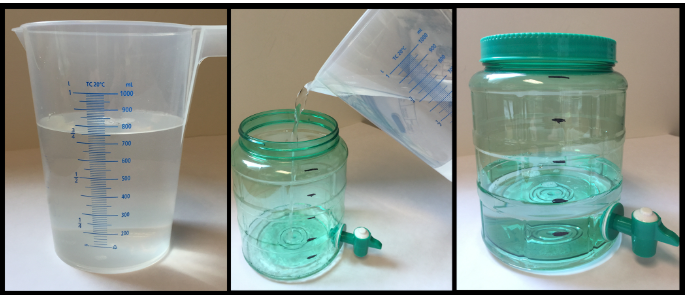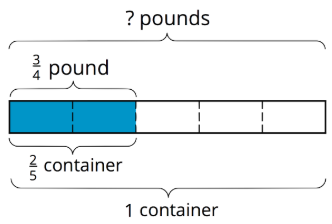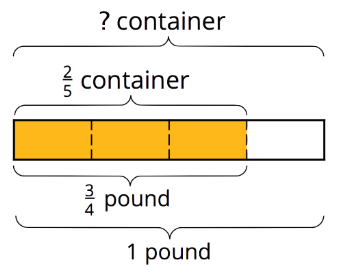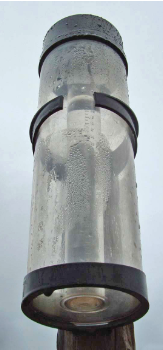22.6: How Much in Each Group? (Part 2)
- Page ID
- 40240
Lesson
Let's practice dividing fractions in different situations.
Exercise \(\PageIndex{1}\): Number Talk: Greater Than 1 or Less Than 1?
Decide whether each quotient is greater than 1 or less than 1.
\(\frac{1}{2}\div\frac{1}{4}\)
\(1\div\frac{3}{4}\)
\(\frac{2}{3}\div\frac{7}{8}\)
\(2\frac{7}{8}\div 2\frac{3}{5}\)
Exercise \(\PageIndex{2}\): Two Water Containers

- After looking at these pictures, Lin says, “I see the fraction \(\frac{2}{5}\).” Jada says, “I see the fraction \(\frac{3}{4}\).” What quantities are Lin and Jada referring to?
- Consider the problem: How many liters of water fit in the water dispenser?
- Write a multiplication equation and a division equation for the question.
- Find the answer and explain your reasoning. If you get stuck, consider drawing a diagram.
- Check your answer using the multiplication equation.
Exercise \(\PageIndex{3}\): Amount in One Group
Write a multiplication equation and a division equation and draw a diagram to represent each situation. Then, find the answer and explain your reasoning.
- Jada bought \(3\frac{1}{2}\) yards of fabric for $21. How much did each yard cost?
- \(\frac{4}{9}\) kilogram of baking soda costs $2. How much does 1 kilogram of baking soda cost?
- Diego can fill \(1\frac{1}{5}\) bottles with 3 liters of water. How many liters of water fill 1 bottle?
- \(\frac{5}{4}\) gallons of water fill \(\frac{5}{6}\) of a bucket. How many gallons of water fill the entire bucket?
Are you ready for more?
The largest sandwich ever made weighed 5,440 pounds. If everyone on Earth shares the sandwich equally, how much would you get? What fraction of a regular sandwich does this represent?
Exercise \(\PageIndex{4}\): Inventing Another Situation
- Think of a situation with a question that can be represented by \(\frac{1}{3}\div\frac{1}{4}=?\). Describe the situation and the question.
- Trade descriptions with a partner.
- Review each other’s description and discuss whether each question matches the equation.
- Revise your description based on the feedback from your partner.
- Find the answer to your question. Explain or show your reasoning. If you get stuck, consider drawing a diagram.
Summary
Sometimes we have to think carefully about how to solve a problem that involves multiplication and division. Diagrams and equations can help us.
For example, \(\frac{3}{4}\) of a pound of rice fills \(\frac{2}{5}\) of a container. There are two whole amounts to keep track of here: 1 whole pound and 1 whole container. The equations we write and the diagram we draw depend on what question we are trying to answer.
- How many pounds fill 1 container?
\(\frac{2}{5}\cdot ?=\frac{3}{4}\)
\(\frac{3}{4}\div\frac{2}{5}=?\)

If \(\frac{2}{5}\) of a container is filled with \(\frac{3}{4}\) pound, then \(\frac{1}{5}\) of a container is filled with half of \(\frac{3}{4}\), or \(\frac{3}{8}\), pound. One whole container then has \(5\cdot\frac{3}{8}\) (or \(\frac{15}{8}\)) pounds.
- What fraction of a container does 1 pound fill?
\(\frac{3}{4}\cdot ?=\frac{2}{5}\)
\(\frac{2}{5}\div\frac{3}{4}=?\)

If \(\frac{3}{4}\) pound fills \(\frac{2}{5}\) of a container, then \(\frac{1}{4}\) pound fills a third of \(\frac{2}{5}\), or \(\frac{2}{15}\), of a container. One whole pound then fills \(4\cdot\frac{2}{15}\) (or \(\frac{8}{15}\)) of a container.
Practice
Exercise \(\PageIndex{5}\)
A group of friends is sharing \(2\frac{1}{2}\) pounds of berries.
- If each friend received \(\frac{5}{4}\) of a pound of berries, how many friends are sharing the berries?
- If 5 friends are sharing the berries, how many pounds of berries does each friend receive?
Exercise \(\PageIndex{6}\)
\(\frac{2}{5}\) kilogram of soil fills \(\frac{1}{3}\) of a container. Can 1 kilogram of soil fit in the container? Explain or show your reasoning.
Exercise \(\PageIndex{7}\)
After raining for \(\frac{3}{4}\) of an hour, a rain gauge is \(\frac{2}{5}\) filled. If it continues to rain at that rate for 15 more minutes, what fraction of the rain gauge will be filled?
- To help answer this question, Diego wrote the equation \(\frac{3}{4}\div\frac{2}{5}=?\). Explain why this equation does not represent the situation.
- Write a multiplication equation and a division equation that do represent the situation.

Exercise \(\PageIndex{8}\)
3 tickets to the museum cost $12.75. At this rate, what is the cost of:
- 1 ticket?
- 5 tickets?
(From Unit 2.3.3)
Exercise \(\PageIndex{9}\)
Elena went 60 meters in 15 seconds. Noah went 50 meters in 10 seconds. Elena and Noah both moved at a constant speed.
- How far did Elena go in 1 second?
- How far did Noah go in 1 second?
- Who went faster? Explain or show your reasoning.
(From Unit 2.3.4)
Exercise \(\PageIndex{10}\)
The first row in the table shows a recipe for 1 batch of trail mix. Complete the table to show recipes for 2, 3, and 4 batches of the same type of trail mix.
| number of batches | cups of cereal | cups of almonds | cups of raisins |
|---|---|---|---|
| \(1\) | \(2\) | \(\frac{1}{3}\) | \(\frac{1}{4}\) |
| \(2\) | |||
| \(3\) | |||
| \(4\) |
(From Unit 2.4.1)

